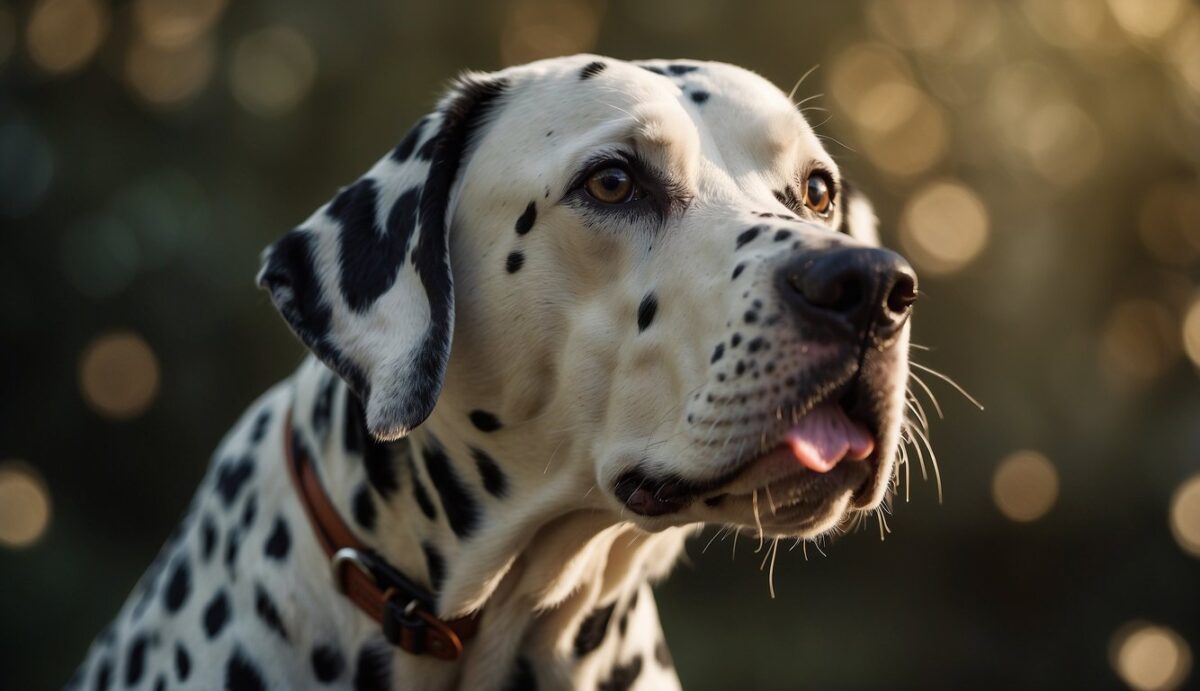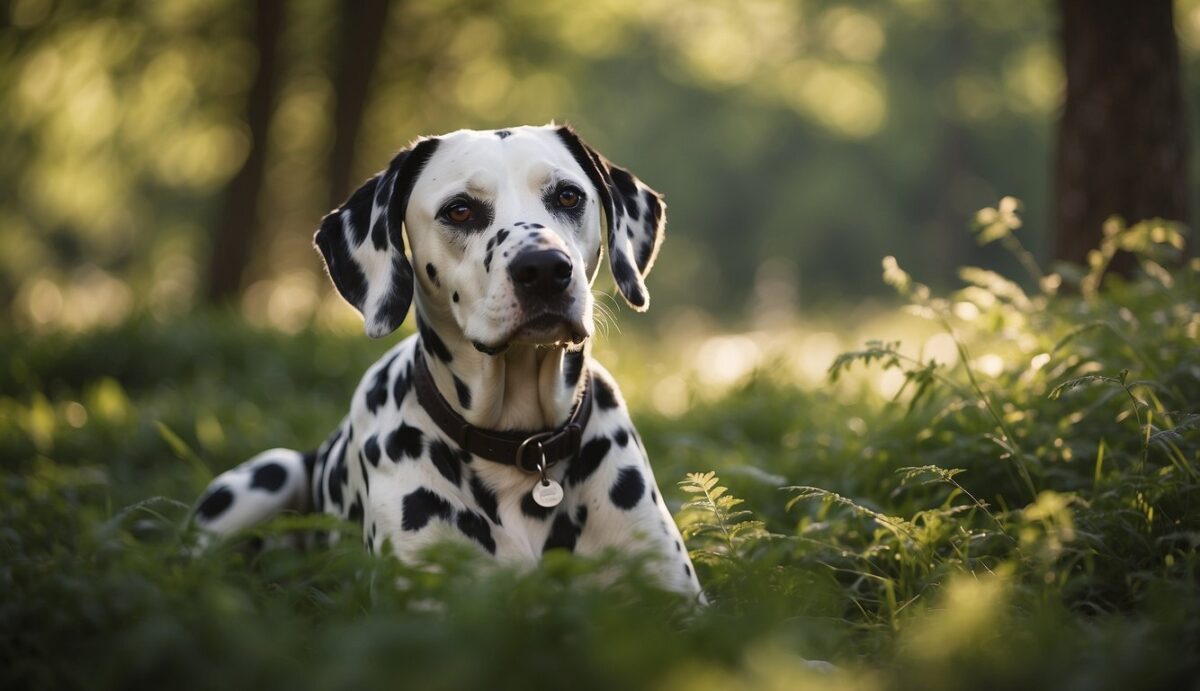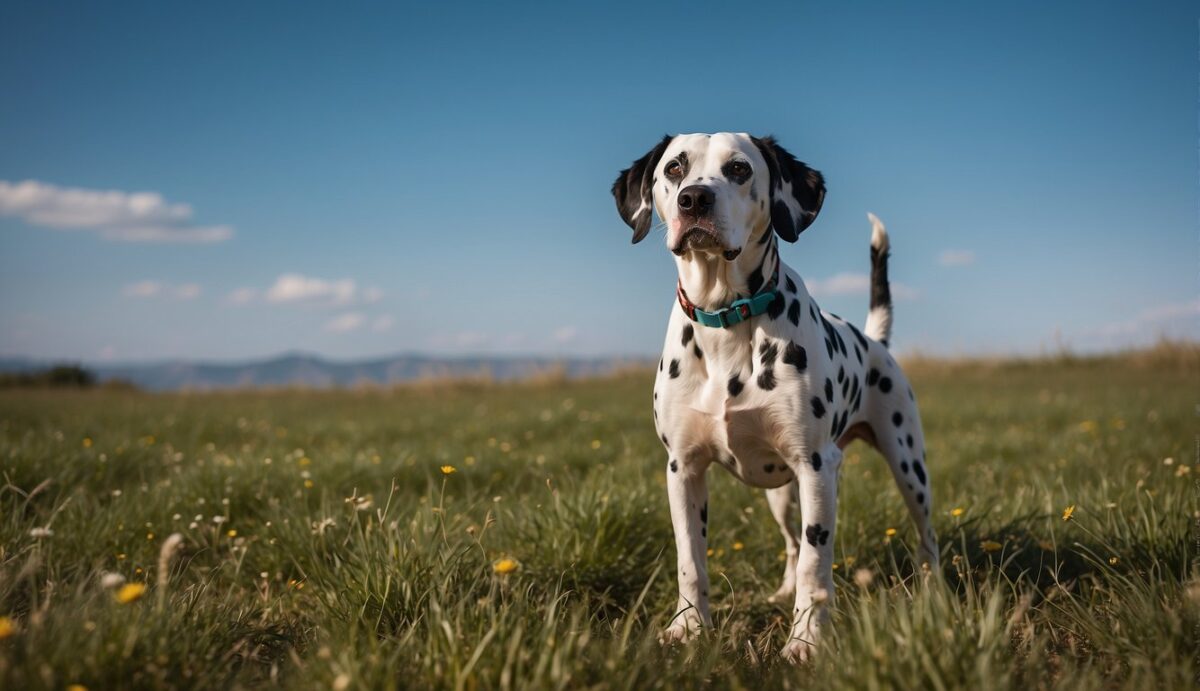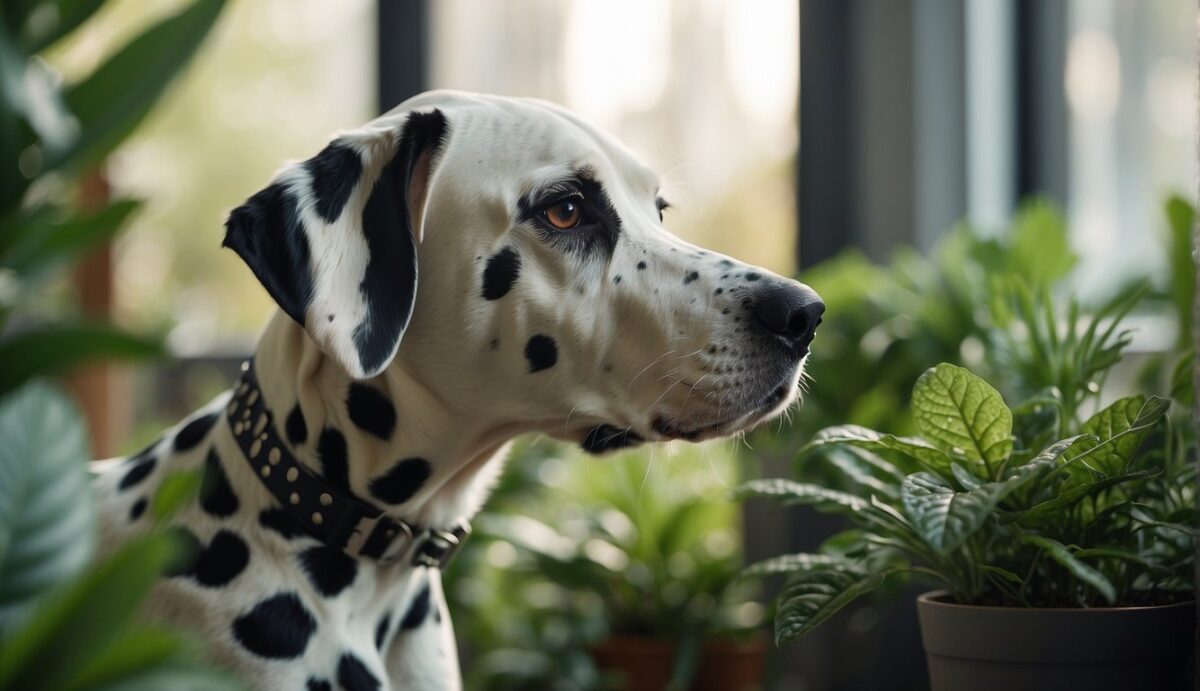Dalmatians are a breed loved for their distinctive spotted coat and energetic demeanor. However, as with any breed, they come with their own set of health considerations, especially when it comes to respiratory health.
Protecting your Dalmatian’s lungs and airways is crucial as they can be prone to certain conditions that affect their breathing.
The lung function in dogs is similar to that in humans, with air traveling through the nose or mouth, down the trachea, into the bronchi, then the smaller bronchioles, and finally into the alveoli where gas exchange occurs.
Keeping these pathways clear and healthy is essential for your dog’s vitality and overall well-being.
Maintaining your Dalmatian’s respiratory health involves several aspects, from understanding the signs of respiratory distress, knowing the common conditions that may affect them, to implementing preventive measures.
It’s not uncommon for Dalmatians to face particular challenges such as upper respiratory infections or congenital deafness that can indirectly affect their respiratory system.
Knowledge of these issues, coupled with regular veterinary check-ups and a clean living environment, can help ensure your companion stays as healthy as possible.
Also, consider the importance of diagnosing respiratory issues early on, which can be pivotal in managing and treating potential diseases effectively.
Key Takeaways
- Understanding how a Dalmatian breathes assists in recognizing signs of respiratory distress.
- Regular vet visits and a clean environment are key to maintaining your Dalmatian’s respiratory health.
- Early diagnosis is essential for effective treatment of respiratory conditions.
Understanding Dalmatian Respiratory Anatomy and Function

Your Dalmatian’s respiratory system is a complex network designed for efficient oxygen intake and carbon dioxide removal. This system also has inbuilt defense mechanisms to protect against foreign bodies and pathogens.
Role of the Lungs and Airways
The lungs and airways work together to ensure your Dalmatian gets the oxygen it needs.
Air enters through the nose, where it’s filtered, warmed, and humidified.
Then it travels down the trachea, which splits into two main bronchi, leading to the lungs.
Inside the lungs, the bronchi divide into progressively smaller tubes called bronchioles that end in tiny air sacs named alveoli. Here, oxygen enters the bloodstream, and carbon dioxide is prepared for exhalation.
The Pathway of Oxygen and Carbon Dioxide
- Inhalation: Oxygen-rich air moves from the nose or mouth through the trachea.
- Exchange: In the alveoli, oxygen passes through the thin membrane to the blood, taking carbon dioxide’s place.
- Exhalation: Carbon dioxide follows the reverse pathway out of your dog’s body.
Understanding this process helps you recognize the importance of keeping your Dalmatian’s respiratory system healthy.
Respiratory System Defense Mechanisms
Your Dalmatian’s respiratory system also serves as a protective agent:
- Nasal Hairs and Mucus: These trap dust and pathogens before they can reach sensitive lung tissue.
- Coughing: This reflex helps to clear the airways of mucus or foreign particles.
- Immune Cells in Alveoli: They detect and fight off potential infections.
These features work tirelessly to defend your dog’s respiratory health, underline the need for clean air and a dust-free environment.
Recognizing Signs of Respiratory Issues in Dalmatians
Being alert to changes in your Dalmatian’s respiratory health can help you catch problems early. Here’s how you can identify the telltale signs of respiratory distress and what symptoms you need to monitor.

Common Symptoms to Monitor
Your Dalmatian relies on you to notice when things aren’t right. Keep an eye out for the following:
- Coughing: An occasional cough may not be a concern, but persistent coughing could indicate an issue.
- Sneezing: Frequent sneezing, along with a runny nose, can signal a respiratory problem.
- Panting: While panting can be normal, especially after exercise, excessive panting might be a red flag.
- Labored Breathing: Difficulty catching their breath or noisy breathing requires attention.
- Lethargy: Reduced energy levels or reluctance to play could be a subtle sign of breathing difficulty.
Identifying Severe Respiratory Distress
Sometimes symptoms are more severe and warrant immediate veterinary care:
- Rapid Breathing: If you observe your dog’s chest moving more quickly than normal, it’s a sign of distress.
- Change in Gum Color: Bluish or pale gums indicate a serious drop in oxygen levels.
- Extreme Lethargy: If your Dalmatian is uncharacteristically tired and unresponsive, they may be experiencing respiratory distress.
- Temperature Regulation Problems: Struggling to stay cool or suddenly overheating can be linked to respiratory trouble.
Common Respiratory Diseases and Conditions

Your Dalmatian’s respiratory health is paramount, and being aware of common diseases and conditions can help you protect your dog’s lungs and airways. This section outlines infectious agents, environmental factors, and chronic conditions that can affect their respiratory system.
Infectious Agents and Diseases
Infectious agents like bacteria and viruses are common culprits behind respiratory diseases in dogs.
The highly contagious kennel cough is one such disease that is typically caused by the bacterium Bordetella bronchiseptica and/or the parainfluenza virus.
It’s important to keep your Dalmatian vaccinated against these agents to reduce the risk of infection.
Canine distemper, a viral infection, poses another threat to your dog’s respiratory health.
Alongside vaccination, minimizing exposure to infected animals is crucial for prevention.
In addition, bacterial pneumonia can develop from a variety of bacteria, manifesting as a serious infection of the lungs that requires prompt veterinary care.
Allergic Reactions and Environmental Irritants
Dalmatians, like other breeds, can develop allergic reactions that affect their respiratory tracts.
Allergies to pollen, dust, mold, or smoke can lead to symptoms like coughing and wheezing, indicating your dog might be experiencing asthma or allergic bronchitis.
To keep your furry friend’s airways clear, avoid smoking around them and maintain a clean living environment.
Regularly updating your home’s air filters can also help reduce airborne irritants that could trigger an allergic response.
Chronic Conditions and Structural Abnormalities
Chronic respiratory conditions, such as bronchitis, can lead to long-term coughing and breathing difficulties for your Dalmatian.
Although not brachycephalic, Dalmatians may still suffer from genetic or acquired structural abnormalities that impact their respiratory efficiency.
Brachycephalic Airway Syndrome typically affects dogs with shorter muzzles, but it’s important for all dog owners to be alert to any signs of breathing difficulties.
If your Dalmatian shows signs of persistent coughing, labored breathing, or intolerance to exercise, it’s essential to seek veterinary assessment.
Diagnostic Methods for Respiratory Health

When your Dalmatian exhibits signs of respiratory issues, such as coughing or difficulty breathing, it’s essential to understand the diagnostic methods veterinarians use to assess their health. This clarity will help you work with your vet to protect your dog’s lung and airway health.
Physical Examinations and History
Your veterinarian will begin with a thorough physical examination and review of your Dalmatian’s medical history.
They’ll listen to your dog’s heart and lungs and look for signs of respiratory distress.
Be prepared to discuss any changes you’ve noticed in your dog’s cough or breathing patterns, as these details are crucial for accurate diagnosis.
Advanced Imaging Techniques
Advanced imaging is instrumental in examining the respiratory system in detail.
X-rays provide an overview of the chest, revealing the state of the lungs and airways.
For more detailed images, a CT scan (computed tomography) might be recommended.
This tool allows your vet to see cross-sectional images of the chest, which can help identify issues such as obstructions or tumors that aren’t visible on standard x-rays.
Sampling and Laboratory Tests
In certain cases, your vet may opt for a tracheal wash or bronchoscopy.
These procedures involve collecting samples from the respiratory tract to identify potential pathogens or evaluate the cells lining the airways.
Samples are then sent to a lab, where they are analyzed for bacteria, viruses, or other concerns.
These tests can be crucial in determining the right course of treatment for your Dalmatian’s respiratory condition.
Treatment and Management of Respiratory Illnesses

In addressing respiratory illnesses in your Dalmatian, it’s important to consider both the medical and lifestyle interventions that can aid in recovery and manage symptoms effectively.
Pharmacological Interventions
Your vet might prescribe antibiotics if your dog has a bacterial infection.
Cough suppressants and expectorants may be used to help ease coughing and promote the clearing of mucus from the airways.
Bronchodilators could also be deployed to open up the airways, making breathing easier for your dog.
Stick closely to the dosing schedule for all medications to ensure the best results.
Supportive Care Practices
Supportive care is crucial and often includes hospitalization to provide oxygen therapy and manage discharge from the nose and eyes.
Ensure your dog gets plenty of fluids to stay hydrated.
It’s also vital to minimize stress, which can exacerbate symptoms and hinder recovery.
Surgical Options in Severe Cases
In rare and severe cases like advanced pneumonia in dogs, surgical intervention might be necessary when other treatments haven’t worked.
Surgical options are considered on a case-by-case basis and usually as a last resort.
Lifestyle and Environmental Adjustments
Make your home a safe haven by reducing irritants like smoke, dust, and allergens which can aggravate respiratory conditions.
Also, keep your dog’s bedding clean to avoid irritation from vomit or other discharges.
Follow through with recommended vaccine schedules to protect against canine influenza and other respiratory pathogens.
Preventive Measures and Best Practices

As a proud Dalmatian owner, there are several key steps you can take to ensure the respiratory health of your spotted companion.
Regular vet checkups, appropriate vaccinations, a well-managed diet, exercise, and maintaining clean air at home are all essential.
Importance of Regular Veterinary Checkups
Regular veterinary checkups are crucial to monitor your Dalmatian’s respiratory health.
These checkups allow for early detection of any potential issues.
Your vet can assess lung function and check for signs of respiratory infections, ensuring your dog’s immune system is capable of warding off diseases.
Vaccinations and Preventive Medications
Vaccines play an essential role in protecting your Dalmatian from infectious and contagious respiratory diseases.
Update your dog’s vaccinations as recommended and ask your vet about preventive medications.
This protects against a range of pathogens that your dog may otherwise be exposed to.
Diet and Exercise Considerations
A balanced diet supports a robust immune system, whereas regular exercise keeps your dog’s muscles, including the diaphragm, strong, enhancing lung capacity.
Keep your dog at a healthy weight to reduce stress on both the respiratory and nervous systems.
- Diet Tip: Incorporate foods that support immune health.
- Exercise Tip: Avoid overexertion and always adapt the exercise to your dog’s fitness level.
Home Environment and Air Quality
Clean air in the home minimizes the inhalation of harmful particles that can affect your Dalmatian’s respiratory health and sense of smell.
Use air purifiers and vacuum regularly to reduce airborne dust and allergens.
- Avoid: Smoke from cigarettes and wood-burning.
- Consider: Investing in a HEPA filter to trap fine particles.
Frequently Asked Questions (FAQs)

Caring for your Dalmatian’s respiratory health is essential. Below are the answers to some frequently asked questions that can help you protect your dog’s lungs and airways.
What are effective home treatments for a dog with upper respiratory infection?
You can ease your dog’s symptoms with rest, hydration, and a humidifier to help keep their airways moist.
Consult your vet before administering any over-the-counter medication.
How can you tell the difference between kennel cough and a more serious upper respiratory infection in dogs?
Kennel cough often presents with a distinct honking cough and is usually not accompanied by severe symptoms.
If your dog has a high fever, lethargy, or difficulty breathing, it may indicate a more serious infection, and you should seek veterinary care immediately.
Are dogs able to transmit respiratory infections to humans or vice versa?
Most canine respiratory infections are species-specific and not a risk to humans.
However, there are exceptions like influenza that can be transmitted between species, so practice good hygiene and consult a veterinarian if you have concerns.
What steps can I take to ensure my dog maintains healthy lungs?
Maintain a smoke-free environment, use pet-friendly cleaners, and provide regular exercise.
Keep up with vaccinations and avoid places where outbreaks of dog infections are happening.
What are the signs that an upper respiratory infection is life-threatening in dogs?
If your dog exhibits extreme lethargy, a bluish tinge to the gums, or a persistent cough that worsens or is accompanied by difficulty breathing, get them to a veterinarian immediately as these could be signs of a life-threatening condition.
How costly is it to perform a tracheal wash on a dog, and what are the benefits?
The cost of a tracheal wash can vary widely depending on your location and the specifics of the procedure.
This diagnostic tool is beneficial for identifying the cause of persistent respiratory issues and tailoring appropriate treatments.

